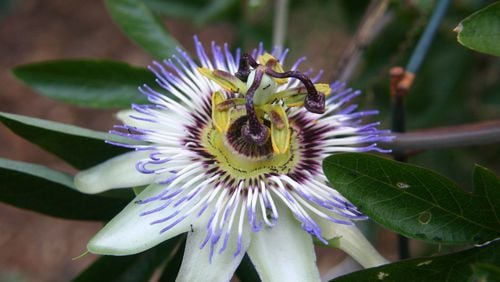Q: I have six passion vines. What can I use to kill the spiked caterpillar that can strip the whole vine in less than a week?Donald Page, email
A: The other-side-of-the-coin nature of butterflies is that they all come from caterpillars. And caterpillars are typically described as "a stomach on legs." So if you admire passion vine, which serves as a host plant for the larvae of the Gulf fritillary butterfly, decisions have to be made. Fortunately, there is an easily available organic caterpillar control. Bacillusthuringiensis (abbreviated as B.t.) is sold in products with names like Dipel or Caterpillar Killer. It is safe for garden use but deadly toward caterpillars of all kinds.
Q: We planted red potatoes but one of the plants has been eaten from the roots.Vickie Phillips, email
A: I think it could be a vole (meadow mouse) eating the potato. These shy creatures make tunnels beneath mulch and weeds to reach their springtime meals of plant roots. Hosta, rose, and camellia roots are commonly chewed to bits. Be sure to keep ground covers and weeds low around your garden in winter. Consider setting a few mousetraps, covered to exclude birds, around your garden.
Q: I have seen plans for making raised beds with cinder blocks. Is there any danger of chemicals leaching into the soil?Mini Rao, email
A: Once upon a time most cinder blocks were made from cinders that were left after coal was burned at power plants. Cinders were used as the "aggregate" that is mixed with cement to make a cinder block. Some cinder blocks are still made using fly ash from a nearby power plant but sand and gravel are more common. In any case the aggregate material is tightly surrounded by cement. It would be very difficult to dissolve the aggregate material to contaminate the soil of your raised bed.
Q: What do you think about eating the fruit from a peach tree that was planted in a septic tank field?Maria Marlowe , email
A: As long as the fruit does not directly touch the ground I would be comfortable eating it. Germs are not absorbed by the roots, so they can't be transmitted to the fruit. Perhaps you could put thick mulch on the ground under the tree or even lay a tarp there to catch fallen fruit.
Q:I'm seeing petunias with white spots on the flower petals. There are no spots on the foliage.Matt Akins, email
A: It’s probably gray mold, Botrytis cinerea, a common disease of flower petals. If a petunia flower is kept constantly moist, the mold will turn the bloom into a gunky mess. But in typical summer weather, heat dries the fungus before it can go further than the initial infection. You can prevent it by spraying with chlorothalonil (Daconil) at planting and during rainy weather.
About the Author






